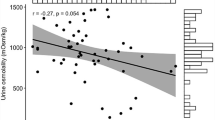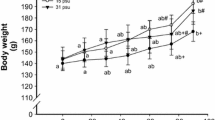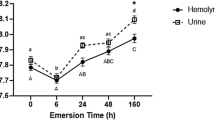Summary
The intestinal caeca reabsorb urinary sodium chloride (NaCl) and water (Rice and Skadhauge 1982). Free water may be generated if the reabsorbed NaCl is secreted via salt gland secretion (Schmidt-Nielsen et al. 1958). Therefore ceacal ligation should (a) reduce hingut NaCl and water reabsorption, (b) enhance the increase in plasma osmolality during saline acclimation, and (c) affect drakes more than ducks. Twelve Pekin drakes and 13 Pekin ducks, Anas platyrhynchos, were caecally ligated or sham operated before acclimation to 450 mmol · 1 NaCl. Body mass, hematocrit, plasma osmolality, and inonic concentrations of plasma, cloacal fluid, and salt gland secretion were measured after each increase in drinking water salinity. Osmoregulatory organ masses were determined. Caecal ligation did not effect plasma osmolality or ion concentrations of plasma, cloacal fluid, or salt gland secretion, but reduced salt gland size in ducks. Drakes and ducks drinking fresh water had the same hematocrit, plasma osmolality, and plasma concentrations of Na+ and Cl−. In both sexes exposure to 75 mmol · 1-1 NaCl significantly decreased plasma [Na+] and doubled cloacal fluid [Na+]. Exposure to 450 mmol · 1-1 NaCl decreased body mass and increased hematocrit, plasma [Na+], [Cl−], and plasma osmolality (more in drakes than in ducks); cloacal fluid osmolality nearly doubled compared to freshwater-adapted ducks, due mainly to osmolytes other than Na+ and Cl−. The [Cl−] in salt gland secretion only slightly exceeded drinking water [Cl−].
Similar content being viewed by others
Abbreviations
- AVT :
-
antiduretic hormone
- CF :
-
cloacal fluid
- ECFV :
-
extraoellular fluid volume
- FW :
-
freshwater acclimated
- Hct :
-
hematocrit
- MDWE :
-
mean daily water flux
- [Na +]cf :
-
cloacal fluid sodium concentration
- [Na +]pl :
-
plasma sodium concentration
- Osm cf :
-
cloacal fluid osmolality
- Osm pl :
-
plasma osmolality
- SGS :
-
salt gland secretion
- TBW :
-
total body water
References
Anderson GL, Braun EJ (1984) Caecae of desert quail: importance in modifying the urine. Comp Biochem Physiol 78A:91–94
Braun EJ, Stallone JN (1989) The occurrence of nephrogenic diabetes insipidus in domestic fowl. Am J Physiol 256:F639-F645
Duke GE, Bird JE, Daniels KA, Bertoy RW (1981) Food metabolizability and water balance in intact and cecectomized greathorned owls. Comp Biochem Physiol 68A:237–240
Farner D (1960) Digestion and the digestive system. In: Marshall AJ (ed) Biology and comparative physiology of birds. Academic Press, New York, pp 443–444
Goldstein DL, Hughes MR, Braun EJ (1986) Role of the lower intestine in the adaptation of gulls (Larus glaucescens) to sea water. J Exp Biol 123:345–347
Gray DA, Kaul R, Brummermann M, Simon E (1987) Dissociation between apparent volumes of distribution for inulin and sodium by salt adaptation in ducks. Pflügers Arch 409:422–426
Hammons RL, Hughes MR, Moldenhauer RR (1988) Body water and water flux in fresh water and sea-water acclimated clapper rails, Rallus longirostris. Comp Biochem Physiol 91A:539–541
Harriman AE, Kare MR (1966) Aversion to saline solutions in starlings, purple grackles, and herring gulls. Physiol Zool 39:123–126
Holmes WN, Fletcher GL, Stewart DJ (1968) The patterns of renal electrolyte excretion in the duck (Anas platyrhynchos) maintained on fresh water and on hypertonic saline. J Exp Biol 48:487–508
Holmes WN, Wright A, Gorsline J (1983) Effects of aldosterone and corticosterone on cloacal water and electrolyte excretion of constantly-loaded intact and colostomized ducks (Anas platyrhinchos). Comp Biochem Physiol 74A:795–805
Hughes MR (1972) Hypertonic salt gland secretion in the glaucouswinged gull, Larus glaucescens, in response to stomach loading with dilute sodium chloride. Comp Biochem Physiol 41A:121–127
Hughes MR (1976) The effects of salt-water adaptation on the Australian black swan, Cygnus atratus (Latham). Comp Biochem Physiol 55A:271–277
Hughes MR (1977) Observations on osmoregulation in glaucouswinged gulls, Larus glaucescens, following removal of the supraorbital salt glands. Comp Biochem Physiol 57A:281–287
Hughes MR (1983) Total body water and its turnover in male and female wild mallard ducks, Anas platyrhynchos, acclimated to fresh water and sea water. Proc Int Union Physiol Sci 15:214
Hughes MR, Roberts JR (1988) Sodium uptake from the gut of freshwater- and seawater-acclimated ducks and gulls. Can J Zool 66:1365–1370
Hughes MR, Ruch FE Jr (1969) Sodium and potassium in spontaneously produced salt gland secretion and tears of ducks, Anas platyrhynchos, acclimated to fresh and saline waters. Can J Zool 47:1133–1138
Hughes MR, Roberts JR, Thomas BR (1989) Renal function in freshwater and chronically saline-stressed male and female Pekin ducks. Poult Sci 68:408–416
Hughes MR, Zenteno-Savin T, Kojwang D (1991) Effects of saline acclimation and caecal ligation on body water and water flux in male and female Pekin ducks. Can J Zool 69:771–775
Niezgoda J (1975) Changes in blood arginine vasotocin level after osmotic stimuli in domestic fowl. Acta Physiol Pol 26:591–597
Niezgoda J (1978) The effect of hemorrhage on blood arginine vasotocin level in the domestic fowl. Acta Physiol Pol 29:107–110
Niezgoda J, Rzasa J (1971) Blood levels of vasotocin in birds. Bull Acad Pol Sci (Ser Biol) 29:359–361
O'Dell BL, Woods WD, Laerdal OA, Jeffay AM, Savage JE (1960) Distribution of the major nitrogenous compounds and amino acids in chicken urine. Poult Sci 39:426–432
Rice GE, Skadhauge E (1982) Caecal water and electrolyte absorption and the effects of acetate and glucose in dehydrated, low-NaCl diet hens. J Comp Physiol B 147:61–64
Roberts JR, Hughes MR (1983) Glomerular filtration rate and drinking rate in Japanese quail, Coturnix coturnix japonica, in response to acclimation to saline water. Can J Zool 61:2394–2398
Schmidt-Nielsen K, Borut A, Lee P, Crawford E Jr (1963) Nasal salt excretion and the possible role of the cloaca in water conservation. Science 142:1300–1301
Schmidt-Nielsen K, Jorgensen CB, Osaki H (1958) Extrarenal salt excretion in birds. Am J Physiol 190:101–107
Simon E (1982) The osmoregulatory system of birds with salt glands. Comp Biochem Physiol 71A:547–566
Skadhauge E (1967) In vivo perfusion studies of the cloacal water and electrolyte resorption in the fowl (Gallus domesticus). Comp Biochem Physiol 23:483–501
Skadhauge E, Munck BG, Rice RE (1984) Regulation of NaCl and water absorption in duck intestine. In: Pequeux A et al. (eds) Lecture notes on coastal and estaurine studies vol 9. Osmoregulation in estuarine and marine animals. Springer, New York, pp 131–142
Thomas DH, Skadhauge E (1979) Dietary Na+ effects on transepithelial transport of NaCl by hen (Gallus domesticus) lower intestine (colon and coprodeum) perfused luminally in vivo. Pflügers Arch 379:229–236
Thomas DH, Skadhauge E (1988) Transport function and control in bird caeca. Comp Biochem Physiol 90A:591–596
Walter A, Hughes MR (1978) Total body water volume and turn-over rate in fresh water- and sea water adapted glaucouswinged gulls, Larus glaucescens. Comp Biochem Physiol 61A:233–237
Ward JM, McNabb RA, McNabb FMA (1975) The effects of changes in dietary protein and water availability on urinary nitrogen compounds in the rooster, Gallus domesticus. I. Urine flow and the excretion of uric acid and ammonia. Comp Biochem Physiol 51A:165–169
Wideman RF, Satnick JL, Mitsos WJ, Bennett KR, Smith SR (1987) Effect of saline adaptation and renal portal sodium infusion on glomerular size distribution and kidney function in domestic fowl. Poult Sci 66:348–356
Wilkinson L (1988) SYSTAT: The system for statistics. Evanston, IL: SYSTAT, Inc
Author information
Authors and Affiliations
Rights and permissions
About this article
Cite this article
Hughes, M.R., Kojwang, D. & Zenteno-Savin, T. Effects of caecal ligation and saline acclimation on plasma concentration and organ mass in male and female Pekin ducks, Anas platyrhynchos . J Comp Physiol B 162, 625–631 (1992). https://doi.org/10.1007/BF00296643
Accepted:
Issue Date:
DOI: https://doi.org/10.1007/BF00296643




